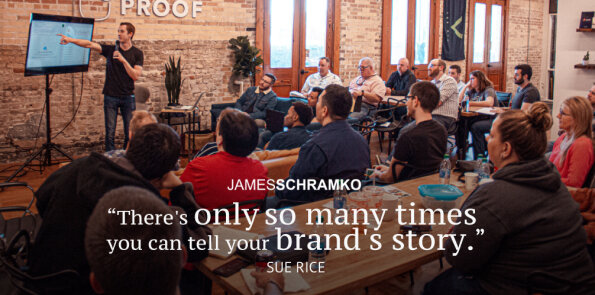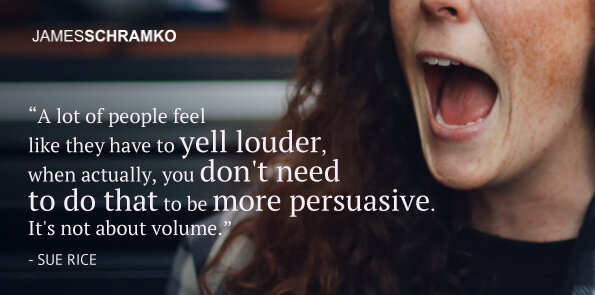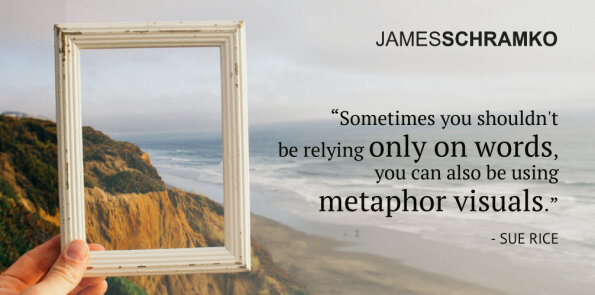Podcast: Download (Duration: 47:42 — 44.4MB)
Get Notified Of Future Episodes Apple Podcasts | Spotify | Amazon Music | Android | Blubrry | Gaana | TuneIn | Deezer | Anghami | RSS | More
On this podcast alone, there are many episodes telling how storytelling sells. Copywriter Sue Rice will tell you, however, that it has to be the right kind of story.
In this interview, she and James go into the premise of her book, Tiny Thunder, and what it says about using stories in marketing.
You’ll discover that the hero’s journey may not be the most effective story framework, and can actually undermine your copy.
And you’ll be introduced to a whole new freedom in storytelling that will make your marketing more engaging and better converting than you thought possible.
Table of contents
1. A really good book
2. Story after story after story
3. An alternative to the hero’s journey
4. It’s the destination that counts
5. Another level of relating
6. The scourge of the cut-and-paste template
7. Effective AND fun
8. How big players influence public thinking
9. The counterintuitive thing about stories
10. Metaphors versus analogies
11. How bad is it to use cliches?
12. Intersecting with the emotion
13. Summing things up
A really good book
James gets sent a lot of books. But when he received Sue’s book, Tiny Thunder, he decided he should talk to her about it on the podcast.
With the interview fast approaching, James got stuck into reading. And he couldn’t put the book down.
In his infrared sauna, James was turning pages. He finished Tiny Thunder in half a day, and – the real mark of a good book – started recommending it to people in his coaching.
Get this book, he told one guy – it will tell you why you could be doing brand storytelling all wrong.
Story after story after story
Exactly right, says Sue. Everyone in marketing thinks stories should be about the brand – but there’s only so many times you can tell your brand’s story.
What’s great about Tiny Thunder is it’s essentially about using any story to illustrate a value, a benefit, a pain point, or a challenge. The runway is infinite.
Take for instance, a story about Steve Jobs, whose wife took eight years to decide on a couch to buy. If you wanted to talk about indecision in your business, wouldn’t that stick in your audience’s head?
Or the story of a guy on a private plane from the Bahamas – with the pilot passed out, this passenger was forced to land the plane in Miami with only air traffic control guiding him. What a perfect way to discuss running a business without help; again, very memorable.
That’s what kept James reading – story after story after story, and revelations of what points were being made. He also liked how Sue talked about where to get stories, and how to choose.
It’s a far cry from the canned rubbish James encounters a lot in communications. What Tiny Thunder teaches is metaphoric storytelling.
An alternative to the hero’s journey
One thing that really hit James was that the famed hero’s journey may not be the best story to tell. It has its place, but more often bits of story – vignettes, Sue calls them – are more apt and impactful, something you can stick into an email or a video for greater engagement.
It’s more of a scene, says Sue, little story snacks of the sort you might chat about with friends – Did you see that meme? Wasn’t that funny?
Springing a whole hero’s journey on people, says James, can feel premeditated, contrived. And people switch off.
And the irony about Tiny Thunder, Sue says, is it uses stories that aren’t actually about your product, to illustrate your product. It’s very different from the linear approach of many copy and paste templates.
It’s the destination that counts
Such a big idea, says James.
And email is a great delivery system for it, says Sue, but so are social media and videos, presentations.
So is coaching, James says. Any kind of sales platform.
James recalls a partner of his who runs an agency, but really wants a membership. He wants to know: what deliveries must he make, how many calls should he offer?
It’s the wrong approach, James tells him. It’s not about what you have to give – it’s about the goals and aspirations of the people you want to serve, and Sue talks about this in her book.
So James tells his partner, your prospects are obsessed with growth, and they want a big payout. Tell them you have the system that will get them there – you have the spaceship, you’ll get them to their destination.
Forget about the nutritional content of their meals, or how long and how frequent the lessons will be – involve them in the big, emotional idea.
It’s the destination, says Sue. People going to Paris don’t care what they’re eating on the plane – they’re thinking of the French cafes and wandering the Parisian streets, the hopes and dreams that the destination embodies.
Another level of relating
James found it fascinating, the meaning that Sue’s students placed on things that humans want. We want to put a story in there – if it’s not there, we’ll create the story.
Imagine the stories we tell about ourselves. And if we can tap into the stories people have of themselves and move them towards something good for them, that’s powerful.
It elevates marketing to a whole other plane, says Sue. If you tell stories that are important to you, and someone relates to those stories, it’s beyond relating around a product – it’s relating at a much higher level, and elicits a much stronger bond.
Which is much more profitable too in the end, and it’s a pity how few people are taking advantage of that.
The scourge of the cut-and-paste template
Another thing about Tiny Thunder, says Sue, is going back to the template-y type messages James receives. That stuff is sludge, both for the reader and the person creating it.
Tiny Thunder is actually fun, because it lets you use all kinds of stories – private stories, stuff from social media, things you read on the news – they’re everywhere. It makes sharing what you do much more enjoyable, and at the same time much more persuasive.
Someone out there teaches these cut-and-paste templates, says James. And it’s critical to understand why they might have worked at one time, instead of turning the brain off and simply using them.
Just the other day, James got a message from someone who addressed him as Lincoln. Dude, James said, you didn’t even put my correct name – the marketer was thoroughly embarrassed.
Effective AND fun
What Sue has provided, says James, is a toolkit on which we can build, rather than a finished product with a promise that it works.
Exactly right, says Sue. And for some people there will be initial discomfort, because copying and pasting is easy.
But if you try Tiny Thunder a couple of times, you’ll realize it’s a simple formula – story, lesson of the story, and a call to action. And you can sound individual, and as Sue has said, it can be fun, both for you and your audience.
James likes how Sue addresses the challenge of thinking up stories. A couple of stories in the book, he’d heard before, but there were plenty he hadn’t.
And that would be the risk in using famous people’s stories, whereas if you leaned into your own, personal material, it would be less likely people had already heard it – that could be an endless well of content.
That is the richest place to start, says Sue, but it’s also good to bring in things people are already talking about, depending on your comfort level.
Like news jacking, says James.
Like that, Sue agrees, but with a twist. Most marketing interrupts, but the nice thing about this method is it joins the conversation.
And Sue feels a lot of people feel like they have to yell louder, when actually, you don’t need to do that to be more persuasive. It’s not about volume.
How big players influence public thinking
James watches Netflix and Amazon, he says, because he wants to see what normal people watch and how they’re being taught to think and feel.
He think it was Steve Jobs who said Disney was once in control of entertainment, and they got to dictate how people think and react.
And it’s true, says James, some of the big content creators are teaching people what to want and aim for. Many people in his industry, for instance, want the magical $10 million revenue (though just quietly, it seems to now be $100 million, thanks to Alex Hormozi).
And some influencers switch narratives, like Gary V – from hustle and grind to love and acceptance and being real. But these power players are a force.
Big players have used tiny thunder, says Sue. Steve Jobs was nothing but metaphoric storytelling, and that’s how he set Apple apart from the great mass of other brands.
The counterintuitive thing about stories
But a friend of Sue’s who read her book said something interesting: This is a narrative that probably buyers will love and sellers will feel less comfortable with.
And Sue does think people feel like if they’re not talking about their product in a really literal and linear way, they’re not going to get the sales. But if you wrap it up in a metaphoric story – she’s seen it with lots of her clients – you get a lot more sales.
What James has found in his sales journey is by focusing on the customer, and solving their problems, which he would understand better, he could relate to them and tell stories that made them much more aware of how their problem was going to be solved, and they’d feel good about it.
When he got married and had kids, he was able to relate to more people. And if you ever attend a parents’ group or a barbecue or a dinner, he says, it’s story after story after story.
It’s about finding the intersection, says Sue, between you and the buyer. That’s what metaphoric stories do – they’re like a bridge across which seller and consumer can both nod yes.
Metaphors versus analogies
James loves how Sue broke down metaphors in the book, putting them in different subcategories. Would she differentiate a metaphor from an analogy?
A metaphor, says Sue, speaking from a literary standpoint, is like a sentence. An analogy is a little bit more, a bigger metaphor, if you will.
Basically the idea of metaphoric thinking is taking an idea from one concept, and applying it to another one.
Sue’s St. Bernard, for instance, is fat, and she calls her a whale – baleine in French – that’s a very small metaphor. An analogy goes a little bit deeper.
And there are similes, like when you say someone is sweet as honey. They’re of the same family – the whole key of metaphoric thinking is comparing two unlike things that share an essence.
An analogy Sue loves is in a scene from Annie Hall, where Diane Keaton and Woody Allen look at each other on a plane. They decide their relationship isn’t working.
Relationship is like a shark, says Woody, and it needs to keep moving. If it doesn’t keep moving forward, it dies – I think what we have on our hands is a dead shark.
You could apply that dead shark analogy to a million different concepts, says Sue And it’s fun, and people will remember it, even if they never even saw Annie Hall.
How bad is it to use cliches?
A friend of James, and a previous guest, Trevor Toecracker Crook, is a stellar copywriter, but he uses cliches a lot. And a cliche sounds a lot like it could be a metaphor.
What Sue tries to avoid, she says, is something that’s been said or used so many times there’s no surprise in it.
She remembers being with someone years ago, who had a young son. And she recalls this son swimming in a pool in Hawaii, at about two years of age.
When the father passed, Sue saw a video of the funeral, and could not believe the 32-year-old man there was the boy she remembered.
You could talk about change being bewildering, says Sue, but a story like that, or a picture of the boy and the man he’d become, was much more powerful.
Sometimes you shouldn’t be relying only on words, you can also be using metaphor visuals, is what Sue is trying to say. And she feels there’s nothing wrong with cliches, but even with a cliche, you can introduce a fresh little twist.
Intersecting with the emotion
If you’re not currently putting metaphors or stories into your marketing, if you’re just product dumping or doing the logic thing, says James, you’re missing out on a whole opportunity.
You’re literally not talking to someone’s whole brain, says Sue. You can’t ignore the logical stuff, but it needs to be dressed up in a bigger way and with stories that go beyond brand storytelling, because everyone knows that formula now.
James loves the story of the guy who lost part of his brain. With it, he lost the ability to feel emotion, and because of that, the capacity as well to make decisions.
A lot of people think emotions, or even storytelling, is like marketing light, says Sue. And it isn’t, because you really need emotions.
You’re seeking an intersection. All the shopping during Christmas, for instance, intersects with the experiences inside the home, the ornaments you’ve had for 15 years and the memories that go with them.
It’s like a photo album with those bits of paper and ink, that evoke such powerful responses. Or the song that takes you back to an old love or something traumatic from your past.
That’s the intersection you want in your marketing.
Summing things up
So in summary, says James, it’s putting that message in, across whatever medium you’re using, whether it’s speaking from stage, running radio ads, sending emails. Use your stories, put meaning to them, and then have a call to action.
That’s pretty much it, says Sue – telling a story that illustrates a value you or your product embodies. It’s telling a story that describes a challenge or a pain point, one that maybe captures a dream that people have, that they can’t get.
Then you tell the lesson. You say, we can help you get to that dream, or we can help you overcome that challenge.
And then you invite them into whatever the next step is. It might be a purchase, or watching a video or reading an article or getting on the phone with you.
James highly recommends you get Sue’s book, Tiny Thunder. You can go to Amazon, or, for much less cost, you can get the digital version and the audio at suerice.com/tinythunder.
Enjoyed the show? Leave us a review on iTunes













Leave a Reply